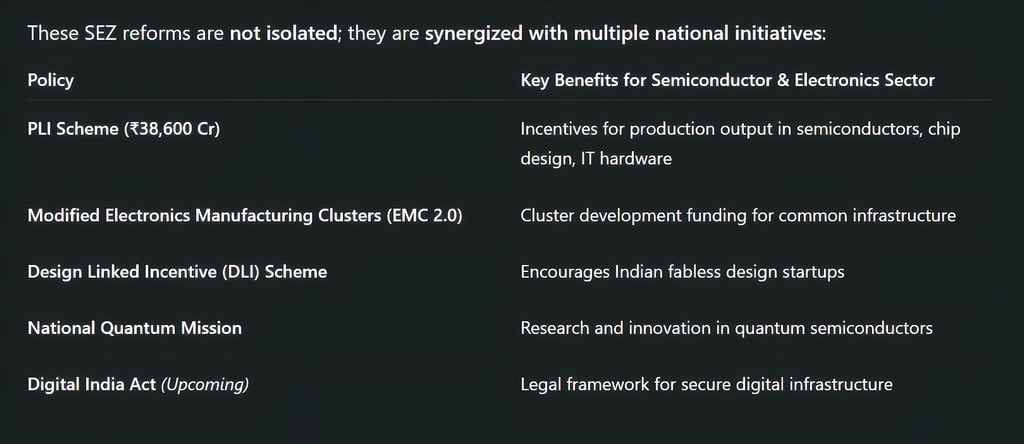
How India’s New SEZ Policy is Attracting Global Semiconductor Giants!
India has officially notified transformative SEZ reforms to accelerate semiconductor and electronics component manufacturing. These updated policies—aligned with the India Semiconductor Mission and PLI schemes—aim to attract global investors, simplify land use, enable domestic sales, and build a world-class chip ecosystem. Explore how these changes empower startups, tech giants, and MSMEs to make India a global electronics hub.
NEWS/CURRENT AFFAIRSSPACE/TECHCOMPANY/INDUSTRYINDIA/BHARAT
Keshav Jha
6/12/20254 min read
In a major policy intervention to advance India’s ambitions in the global semiconductor and electronics sector, the Government of India has officially notified reforms to the Special Economic Zones (SEZ) framework. These updates, aligned with the broader push for "Make in India," "Atmanirbhar Bharat," and the India Semiconductor Mission (ISM), aim to make the country a powerhouse in chipmaking, electronics component manufacturing, and high-tech exports.
These reforms come at a crucial time when geopolitical tensions, supply chain bottlenecks, and technological transitions have prompted countries worldwide to localize and diversify their semiconductor ecosystems. India is seizing this moment to emerge as a viable global alternative.
Key Highlights of the SEZ Reforms (2025 Update)
Deemed SEZ Area for Domestic Sales
SEZs can now sell up to 50% of their total production in the Domestic Tariff Area (DTA) at regular duties (earlier, high duties discouraged domestic sales).
This brings cost parity and greater market flexibility for electronics component and chip manufacturers to cater to India’s growing internal demand.
Fast-Track De-Notification of Inactive SEZ Land
Land held by SEZs but unused or underutilized for over 3 years can now be de-notified via a simplified, time-bound online process.
This reform frees up land parcels for new players in semiconductors, packaging units, testing facilities, and embedded hardware startups.
Unified Industrial Zones via DESH Bill
The long-awaited Development of Enterprise and Services Hub (DESH) Bill, replacing the SEZ Act 2005, is being fast-tracked.
Under DESH:
Zones can be multi-sectoral and service-integrated.
There is no export obligation—allowing balanced domestic and global servicing.
Simplified customs procedures will replace the current dual control of SEZs by both state and central agencies.
Strategic Sector Focus: Semiconductors & Electronics
These reforms are laser-focused on sectors critical to India's technological independence:
A. Semiconductors
India is investing ₹76,000 crore (~$9.2B) under the Semicon India Programme for:
Silicon fabs (e.g., Micron, Tata Group)
OSAT/ATMP units (Outsourced Semiconductor Assembly and Test)
Display fabs (AMOLED, LED, LCD)
Fabless design innovation (RISC-V, AI SoCs, edge chips)
B. Electronics Components
India's import dependency is highest for:
Passive components (resistors, capacitors)
PCBs, ICs, sensors, lithium battery packs, and embedded modules.
SEZ reforms now encourage local component assembly, raw material value addition, and deep tech R&D within India.


India’s Global Semiconductor Moves (2024–2025)
Major Project Updates
Micron’s ATMP Unit in Gujarat—phase 1 already under development with $825M investment.
Tata Group’s chip fab—set for construction in Dholera; talks ongoing with UMC (Taiwan).
Renesas-Tata Partnership—advancing automotive and industrial chip design.
Foxconn-Vedanta Split—both exploring separate fabs in Gujarat and Maharashtra, respectively.
Strategic MoUs & Alliances
MoUs with TSMC, Intel, and GlobalFoundries are being negotiated for backend and packaging collaborations.
India-U.S. Semiconductor Supply Chain Agreement signed under IPEF (Indo-Pacific Economic Framework).
Who Benefits from These Reforms?
Global Semiconductor Giants
Easier land access, streamlined logistics, and policy clarity make India an attractive option for backend, ATMP, and R&D centers.
Indian Tech Startups
Fabless chip startups, sensor makers, EV component developers, and embedded AI players now have land and lab space opportunities in SEZs.
MSMEs & Tier-2 Manufacturers
SMEs dealing in cables, PCBs, SMD components, etc., can set up shop with shared infrastructure and reduced compliance burden.
Researchers & Design Professionals
The SEZs will also host Innovation Zones and Academic-Industry Labs, fostering next-gen IC design, chip modeling, and photonics work.
FAQs
Q1. What are the recent SEZ reforms notified by the Government of India in 2025?
The 2025 SEZ reforms include allowing up to 50% domestic sales from SEZs at regular duties, fast-track de-notification of idle SEZ land, and simplifying compliance through the upcoming DESH Bill. These changes aim to attract semiconductor and electronics manufacturers by easing land use, reducing export-only restrictions, and encouraging domestic market integration.
Q2. How do SEZ reforms benefit India’s semiconductor industry?
The reforms make it easier for companies to set up fabs, chip assembly units (OSAT/ATMP), and design centers in India by offering regulatory clarity, land access, and integration with PLI incentives. This supports India’s goal to become a global semiconductor hub and reduce reliance on imports.
Q3. What is the DESH Bill, and how is it different from the older SEZ Act?
The DESH (Development of Enterprise and Services Hub) Bill replaces the SEZ Act 2005. It removes export obligations, allows multi-sectoral zones, and simplifies procedures. DESH aims to convert SEZs into innovation-friendly, globally integrated industrial zones.
Q4. Can SEZ units now sell in the domestic Indian market?
Yes, SEZ units can now sell up to 50% of their total production in the Domestic Tariff Area (DTA) at applicable duties, making it more profitable to serve both domestic and export markets.
Q5. Which locations in India are emerging as key semiconductor SEZ clusters?
Major hubs include Dholera (Gujarat), Sanand (Gujarat), Sriperumbudur (Tamil Nadu), Hyderabad (Telangana), Yamuna Expressway (Uttar Pradesh), and Bengaluru (Karnataka). These locations are attracting global and Indian semiconductor investments.
Q6. How do these reforms affect MSMEs and local component manufacturers?
Reforms simplify land access and compliance, allowing MSMEs in electronics components (PCBs, sensors, cables, etc.) to participate in SEZ zones and benefit from infrastructure, logistics, and co-location with larger chipmakers and R&D centers.
Q7. How are SEZ reforms aligned with India’s PLI and Semiconductor Mission?
The SEZ reforms complement the Production Linked Incentive (PLI) schemes and the Semicon India Programme by creating a favorable ecosystem—land, compliance, and market flexibility—for eligible companies to invest and scale within India.


These SEZ reforms represent India’s pivot from being a consumer of chips to becoming a global contributor. With land, law, and logistics finally aligned, India is not only offering capital and incentives but also creating a fertile environment for deep-tech innovation.
By removing barriers and inviting global collaboration, the SEZ reforms are a green signal to every electronics and semiconductor visionary: “Build your future from India.”
Subscribe to our newsletter
All © Copyright reserved by Accessible-Learning
| Terms & Conditions
Knowledge is power. Learn with Us. 📚


